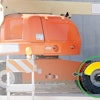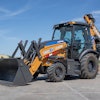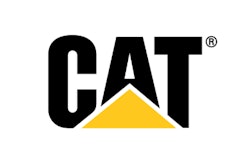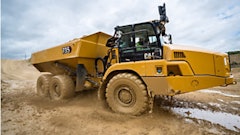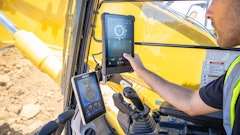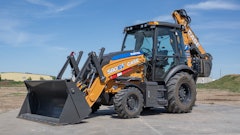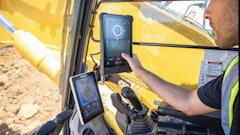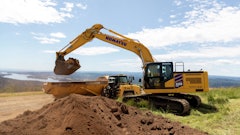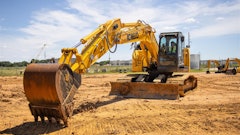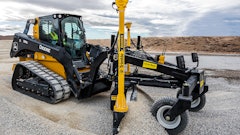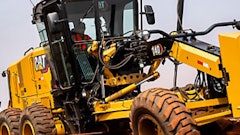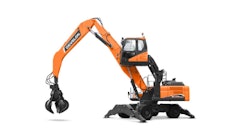Equipping an excavator for underwater or amphibious applications requires careful planning. While the applications will vary, they all have a couple of things in common - you will be working in environmentally sensitive areas, and the machines will be constantly exposed to water. This calls for some added precautions.
"Equip the excavator with an automatic greasing system," advises Matt Hendry, Deere & Company. "Water does not compress and will get in and force the grease out of pins/bushings. Small amounts of grease pumped into joints at regular intervals will lengthen [pin/bushing] life."
Lubricants should also be compatible with the environment. "We usually go with lithium grease for anything that is going to be extended life in the water," says Kent Pellegrini, Caterpillar.
Kokosing Construction Company Inc. is a large contractor that performs underwater excavation work around the Great Lakes. "We do a lot of water outflows and we lay pipe underwater," says Aaron Harke.
Because of the nature of its work, the company voluntarily takes precautions with lubricants. "We convert everything over to environmentally friendly materials," says Harke. "If we do have a hydraulic leak, we theoretically have not caused anybody any heartache. We just made a mess [that we] have to clean up."
Such steps provide peace of mind, says Harke. "As a manager, not having to worry about a hydraulic leak is a big deal," he says. "Things are going to fail. I don't care if you are on land or water, you need to be prepared for it."
Working near saltwater may require further adaptations of the equipment, such as specialized paint to minimize wear and corrosion. For issues unique to your jobsites, your equipment dealer is your best resource. "Dealers do a little extra depending upon what you're getting into," says Pellegrini.
Underwater vision
Available options can further transform your excavators into highly efficient underwater tools. Take GPS grade control, for example.
Traditionally, Kokosing Construction has relied heavily on cranes with clamshell buckets for underwater excavation. But recently, it has been using excavators more for jobs where reach isn't an issue.
"Part of the reason is it has become so much easier to control grade and elevations," says Harke. "We installed Trimble systems on our excavators. That allows us to be within a couple tenths when we are digging with the excavator. That is a tremendous benefit.
"We have been easing into the whole GPS program for some time," he adds. It started with positioning of barges. "We know the barge is facing the right direction, so we could cut a straight trench and keep track of stationing."
The recent advancement of GPS with Real Time Kinematic (RTK) now allows Kokosing to more easily control grades and elevations. "It shows you the position of the bucket, so you know if you are teeth down or teeth up," Harke explains. "It has both plan and profile views when you are working, so the operator can toggle between them or he can set up two screens so he knows if he is on the centerline. He knows exactly where he is."
Obstacles are also easy to locate and mark. "When we are dredging and they run across a rock formation, they can put the bucket right on the rock and tell us within feet where it is in relation to the rest of the world," says Harke. "That is pretty helpful."
Caterpillar's AccuGrade system is also suited for underwater projects. "The AccuGrade really plays into this well in knowing where your slope is underwater," says Pellegrini. "You can stay within 5% to 10% deviation, if that is what the bid recommends."
Trying to account for all of the variables when working underwater can be daunting. "That is why you will see deviations from 5% to 10%, because they are usually adjusting for water rising or lowering or tides [going] in or out," says Pellegrini.
AccuGrade takes the guesswork out of underwater slope work. It can also be used to identify obstacles. "If there are any monuments in the water, or electrical lines coming through, it will be marked," says Pellegrini. "With the 3-D GPS Cat AccuGrade program, you can load that into the system."
Extended reach
Long-reach excavators are a popular option for underwater tasks where you can trade off dig and lift capacity for added reach. However, they do require some adjustments to the carrier.
"Long front configurations require additional counterweight packages to balance the machine," notes Hendry. "A general rule of thumb is it is okay to add up to 5% of the original machine's weight in additional counterweight. Caution needs to be taken, [since] too much additional weight may affect structure and swing bearing life.
"Consult your boom/arm supplier and the excavator OEM for the appropriate counterweight recommendations," he advises.
You will also need to adjust hydraulic capacities to match the new geometry. "Relief settings on the host excavator are reduced when long fronts are used in order to protect the machine and front structures," Hendry points out.
Some attachment manufacturers, such as Paul Wever Construction Equipment (PWCE), offer several boom and stick options. For example, the PWCE Extendavator can be used on 25,000- to 500,000-lb. excavators, providing an economical alternative to dedicated long reach machines.
NY-based Algonquin Power Systems has seven years of experience using the PWCE attachment. Mounted on a Takeuchi TB070, the attachment is used to clean intake racks from debris that comes down the river before it clogs water flow to the hydroelectric plant.
"The only special thing we did to the excavator was back off the hydraulics a bit," says Walter Bracy. "It has a special rake on the end of it. The attachment is 3 ft. wide and 1 1/2 ft. deep with sides on it. It's sort of like a big spatula."
The racks extend down at an angle 20 ft. deep. "We fully stretch the boom out and go to the bottom. Once the rake attachment is against the racks, we just slowly slide up," says Bracy. "That cleans the debris off the rack and we just put it all in a dumpster."
The long-reach attachment takes no special skills to operate. "If you can operate a TB070, you can operate that," Bracy says. In addition, the machine with attachment can be transported on a lowboy, which makes it easy to service the company's numerous New York sites.
Undercarriages provide flotation
Replacing a traditional excavator undercarriage with an amphibious version enables an excavator to work in shallow waters and marshes without support equipment. "I can drive in there, do the work and drive out," says Jody Simoneaux, Wetland Equipment.
Wetland Equipment's amphibious undercarriages consist of two pontoons wrapped by wide tracks. "Our pontoons weigh less than the conventional undercarriage," says Simoneaux. "Our footprint is larger, so it actually leaves less impression on the ground. The tracks produce 2 psi max., even on our largest machines. The smaller machines are actually less than that."
The undercarriages are particularly effective in long reach applications. "We design everything for super long reach," says Simoneaux. And the product line covers all makes of excavators. "We re-balance every machine."
Because the machines often work in remote environments, custom fuel tanks are an option. The tanks replace the stock counterweight and are weighted to provide the manufacturer-recommended balance when empty.
Of course, safety is a primary consideration in the amphibious undercarriage design. "The No. 1 concern is rolling over and having a man drown," says Simoneaux.
To address this, Wetland Equipment builds in reserve flotation. "We reserve 20% buoyancy, so 20% of the pontoon will be out of the water for the safety of the employees. You can actually swing sideways with our equipment and it will not tip over," Simoneaux asserts. "I have guys who have had them for years and actually do work over the side."
The undercarriages are also engineered specifically to meet the extreme demands of their work environment. "I don't use anything from the original undercarriage," says Simoneaux. The motors and gearboxes from the land machines are not strong enough. "Everything from the swing gear down is ours."
Roller chains are also designed to survive in a liquid environment. "They are steel-on-steel bushings," says Simoneaux.
Dedicated to aquatics
Douglas Amphibious, Camden, TN, digs ditches and cleans up waterways and sediment ponds. Its fleet includes three dedicated amphibious excavators, including one from Wetland Equipment, plus three conventional excavators.
Randy Douglas bought his first amphibious excavator in 1999. Before that, he would swap out between amphibious and conventional undercarriages. "I couldn't afford to have both [machine types]," says Douglas, noting the size class of machines he uses range from $125,000 to $160,000. "When you get the bigger machines, it is more expensive."
The swap required a little effort. "It took about 10 hours with two men. You have to have at least a 30-ton crane for our machines. There are a few hoses and 37 bolts," Douglas points out. "We have been fortunate that we upgraded and we don't have to swap anymore."
The amphibious excavators feature standard long-reach sticks with a 34-ft. reach and standard 42-in. buckets with thumbs. However, they feature customized fuel tanks. "We pull our counterweights and build our own [fuel] tanks. Ours is plumbed right into the machine," Douglas notes. "We try to add back enough in our counterweight to get pretty close to what it was before we put fuel in it."
The amphibious excavators can access sensitive areas with minimal damage. "You can run over lily pads and they will just pop up behind you as long as you don't turn," says Douglas. "In 3 ft. of water, you are putting practically no pressure on the ground. There is no way a man can start to walk where this thing will go. It will float in 5 or 6 ft. of water."
But you do need to use an amphibious undercarriage in the proper applications. "We track the machines a half mile to a mile every day," says Douglas. "We are in water. You get on land and you will eat the undercarriage in a few hours. They are not designed for dry land. They are built to be where it is muddy. If it is not wet, we will bring our land track machines in."
Overall, the machines have held up well given their harsh operating environment. "I retired one this year. It had 11,000 hours on it," Douglas says. "They are pretty rugged."

